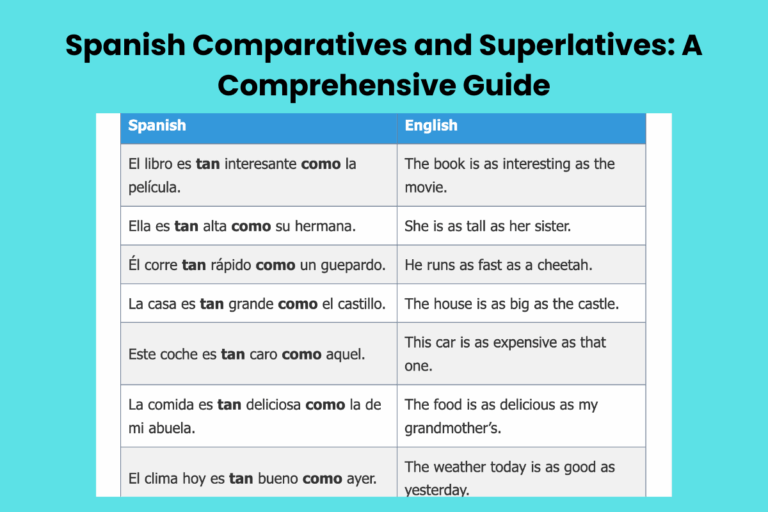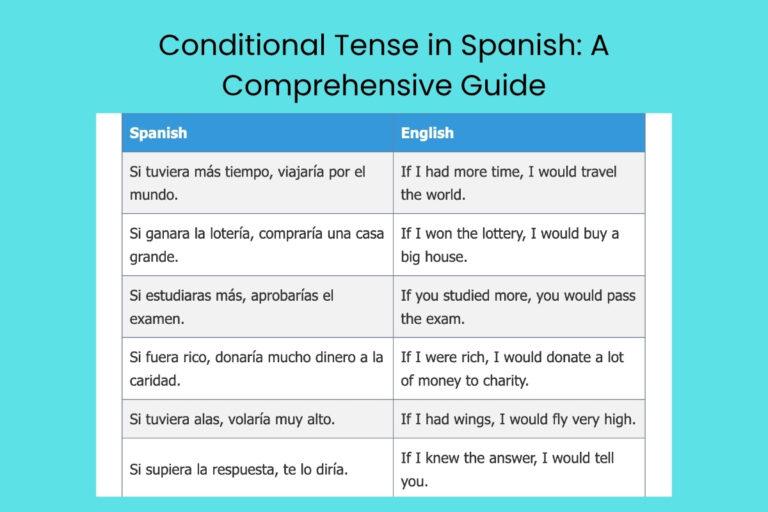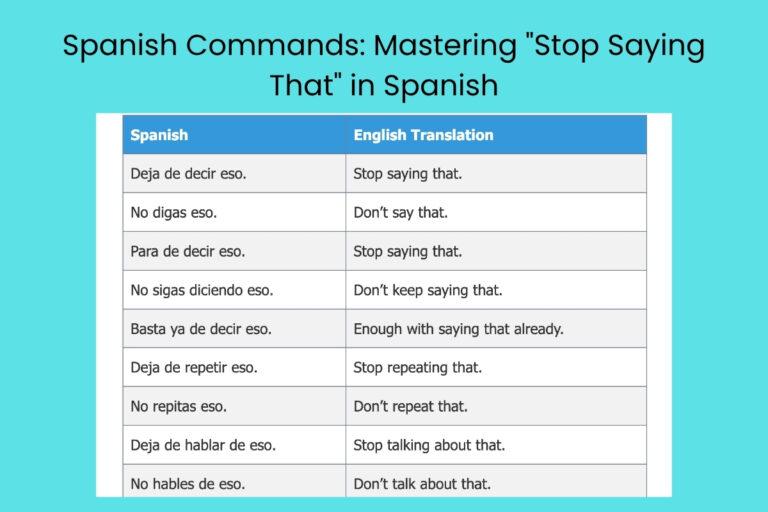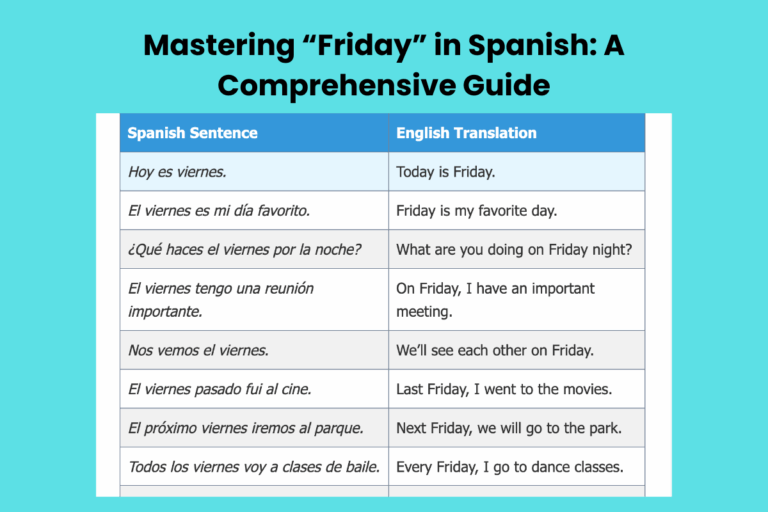Spanish Adjectives Starting with Y: A Comprehensive Guide
Understanding Spanish adjectives is crucial for describing nouns and adding detail to your sentences. While many adjectives in Spanish follow predictable patterns, those starting with the letter “y” can sometimes be overlooked.
This article provides a comprehensive guide to Spanish adjectives starting with “y,” covering their meanings, usage, and common applications. Whether you’re a beginner or an advanced learner, this resource will enhance your vocabulary and improve your ability to express yourself effectively in Spanish.
This guide is particularly useful for students preparing for exams, travelers wanting to enrich their communication skills, and anyone passionate about mastering the Spanish language.
Table of Contents
- Introduction
- Definition of Spanish Adjectives Starting with Y
- Structural Breakdown of Spanish Adjectives
- Types and Categories
- Examples of Spanish Adjectives Starting with Y
- Usage Rules for Spanish Adjectives
- Common Mistakes
- Practice Exercises
- Advanced Topics
- FAQ
- Conclusion
Definition of Spanish Adjectives Starting with Y
In Spanish, adjectives are words that modify nouns, providing more information about their characteristics, qualities, or attributes. Adjectives starting with “y” are relatively rare compared to those starting with other letters, but they are essential for expanding your vocabulary and expressing specific ideas.
These adjectives, like all Spanish adjectives, must agree in gender (masculine or feminine) and number (singular or plural) with the nouns they modify. Understanding this agreement is fundamental to correct Spanish grammar.
The primary function of an adjective is to describe or qualify a noun. Adjectives can indicate size, color, shape, origin, or any other quality that distinguishes the noun.
In the case of adjectives starting with “y”, their specific meanings can range from describing substances to qualities of places. Their context dictates the precise nuance of their usage.
The context in which an adjective is used is crucial for understanding its meaning and application. For example, an adjective describing a physical property will be used differently than one describing an emotional state.
Being aware of the context will help you to use these adjectives correctly and effectively. The meaning of an adjective can also change slightly depending on the region or dialect of Spanish being spoken.
While the core meaning remains consistent, subtle variations in usage are possible.
Structural Breakdown of Spanish Adjectives
Spanish adjectives, including those starting with “y,” typically follow the noun they modify. This is a key difference from English, where adjectives usually precede the noun.
However, there are exceptions, particularly with certain adjectives that change their meaning depending on their position relative to the noun. These are often referred to as apocopated adjectives.
The agreement in gender and number is a critical aspect of Spanish adjective structure. Masculine nouns typically take the “-o” ending, while feminine nouns take the “-a” ending.
Plural forms are usually created by adding “-s” or “-es” to the singular form. Thus, the adjective must change its ending to match the noun it modifies.
For example, if you are describing a masculine singular noun, the adjective must also be in the masculine singular form.
Consider the example of the adjective “yermo” (barren). If you are describing “terreno” (masculine singular), you would say “terreno yermo”.
If you are describing “tierra” (feminine singular), you would say “tierra yerma.” If you are describing multiple barren lands (“terrenos”), you would say “terrenos yermos”. If you are describing multiple barren lands (“tierras”), you would say “tierras yermas”.
This shows the importance of gender and number agreement in Spanish grammar. The ending of the adjective must always match the noun it is describing.
Types and Categories
While the list of Spanish adjectives starting with “y” is not extensive, they can be categorized based on their meaning and usage. These categories help in understanding the nuances of each adjective and how they contribute to descriptive language.
Descriptive Adjectives
Descriptive adjectives provide specific details about the qualities or characteristics of a noun. These adjectives can describe physical attributes, emotional states, or other distinguishing features.
For example, an adjective might describe the appearance of a landscape or the emotional state of a character in a story.
Qualitative Adjectives
Qualitative adjectives describe the inherent qualities of a noun. These adjectives often express subjective opinions or judgments about the noun’s nature.
For instance, a qualitative adjective might describe the overall impression or feeling associated with a place.
Relational Adjectives
Relational adjectives indicate a relationship or connection between the noun and something else. These adjectives often specify the origin, purpose, or association of the noun.
For example, a relational adjective might describe the connection between a place and its historical significance.
Examples of Spanish Adjectives Starting with Y
Here are some examples of Spanish adjectives starting with “y,” categorized for clarity. Each example includes the adjective in its masculine and feminine forms, along with an English translation and example sentence.
Table 1: Common Spanish Adjectives starting with “Y”
The following table showcases some of the most common Spanish adjectives starting with the letter “Y,” along with their masculine, feminine, and English translations. These examples are fundamental for building a basic understanding of adjectives beginning with “Y.”
| Adjective (Masculine) | Adjective (Feminine) | English Translation | Example Sentence | English Translation of Sentence |
|---|---|---|---|---|
| Yermo | Yerma | Barren, desolate | El terreno es yermo. | The land is barren. |
| Yucateco | Yucateca | From Yucatan | La comida yucateca es deliciosa. | The Yucatecan food is delicious. |
| Yugoslavo | Yugoslava | Yugoslavian | La historia yugoslava es compleja. | Yugoslavian history is complex. |
| Yanqui | Yanqui | Yankee | Algunos latinoamericanos llaman “yanqui” a los estadounidenses. | Some Latin Americans call Americans “Yankee.” |
| Yakuto | Yakuta | Yakut | La cultura yakuta es fascinante. | The Yakut culture is fascinating. |
| Yemení | Yemení | Yemeni | El café yemení es muy apreciado. | Yemeni coffee is highly valued. |
| Yiddish | Yiddish | Yiddish | El idioma yiddish tiene una rica historia. | The Yiddish language has a rich history. |
| Yo | Yo | I (used in specific contexts, archaic) | Yo soy el rey. (archaic) | I am the king. (archaic) |
| Yacente | Yacente | Reclining, lying down | La estatua yacente era impresionante. | The reclining statue was impressive. |
| Yodado | Yodada | Iodized | La sal yodada es importante para la salud. | Iodized salt is important for health. |
| Yacimiento | Yacimiento | Deposit (resource) | El yacimiento petrolífero es enorme. | The oil deposit is enormous. |
| Yesero | Yesera | Gypsum-related | La industria yesera es importante en esta región. | The gypsum industry is important in this region. |
| Yardero | Yardera | Related to a yard (archaic) | El trabajo yardero era arduo. | The yard work was arduous. |
| Yatagán | Yatagán | Yataghan (a type of sword) | El yatagán otomano era afilado. | The Ottoman yataghan was sharp. |
| Yarey | Yarey | Made of Yarey (a type of palm) | La cesta de yarey es resistente. | The Yarey basket is durable. |
| Yatoso | Yatosa | Full of mud (regional) | El camino yatoso dificultaba el paso. | The muddy road made it difficult to pass. |
| Yinglés | Yinglesa | Referring to someone from England (Rarely Used) | El turista yinglés visitó el museo. | The English tourist visited the museum. |
| Yerboso | Yerbosa | Grassy, full of grass | La llanura yerbosa se extendía hasta el horizonte. | The grassy plain stretched to the horizon. |
| Yesificado | Yesificada | Gypsum-containing | La tierra yesificada no es buena para cultivar. | The gypsum-containing soil is not good for cultivation. |
| Yodal | Yodal | Related to iodine | El tratamiento yodal fue efectivo. | The iodine treatment was effective. |
Table 2: Geographic Adjectives
This table focuses on adjectives that describe places or origins, particularly those related to specific regions or countries. These adjectives are useful for indicating the provenance or cultural association of a noun.
| Adjective (Masculine) | Adjective (Feminine) | English Translation | Example Sentence | English Translation of Sentence |
|---|---|---|---|---|
| Yorkino | Yorkina | From York (England) | El acento yorkino es distintivo. | The York accent is distinctive. |
| Yacochuyano | Yacochuyana | From Yacochuya (Argentina) | El vino yacochuyano es de alta calidad. | The Yacochuya wine is of high quality. |
| Yaguaronino | Yaguaronina | From Yaguarón (Paraguay) | La artesanía yaguaronina es muy colorida. | The Yaguaron handcrafts are very colorful. |
| Yaguense | Yaguense | From Yagua (Peru) | La cultura yaguense es ancestral. | The Yagua culture is ancestral. |
| Yarumaleno | Yarumalena | From Yarumal (Colombia) | El café yarumaleno es muy famoso. | The Yarumal coffee is very famous. |
| Yacureño | Yacureña | From Yacurí National Park (Ecuador) | La flora yacureña es diversa. | The Yacurí flora is diverse. |
| Yaravi | Yaravi | Relating to Yaraví (traditional Andean song) | La melodía yaraví es melancólica. | The Yaraví melody is melancholic. |
| Yapeyuano | Yapeyuana | From Yapeyú (Argentina) | La historia yapeyuana es rica en cultura. | The Yapeyú history is rich in culture. |
| Yarinacoquense | Yarinacoquense | From Yarinacocha (Peru) | La laguna yarinacoquense es hermosa. | The Yarinacocha lake is beautiful. |
| Yataiteño | Yataiteña | From Yataití del Norte (Paraguay) | La gente yataiteña es amable. | The people from Yataití are friendly. |
| Yungueño | Yungueña | From Los Yungas (Bolivia) | El clima yungueño es subtropical. | The Los Yungas climate is subtropical. |
| Yacuibeño | Yacuibeña | From Yacuiba (Bolivia) | La música yacuibeña es folklórica. | The Yacuiba music is folkloric. |
| Yaguachiño | Yaguachiña | From Yaguachi (Ecuador) | La tradición yaguachiña es importante. | The Yaguachi tradition is important. |
| Yanahuaranino | Yanahuaranina | From Yanahuara (Peru) | El paisaje yanahuaranino es pintoresco. | The Yanahuara landscape is picturesque. |
| Yaracalense | Yaracalense | From Yaracal (Venezuela) | La cultura yaracalense es vibrante. | The Yaracal culture is vibrant. |
| Yavirense | Yavirense | From Yaviri (Peru) | La comunidad yavirense es unida. | The Yaviri community is united. |
| Yunguyo | Yunguyo | From Yunguyo (Peru) | El puerto yunguyo es activo. | The Yunguyo port is active. |
| Yavi | Yavi | From Yavi (Argentina) | La iglesia de Yavi es histórica. | The Yavi church is historic. |
| Yarital | Yarital | From Yarital (Colombia) | La gente yarital es muy amable. | The people of Yarital are very friendly. |
| Yata | Yata | From Yata (Bolivia) | El pueblo de Yata es pequeño. | The town of Yata is small. |
Table 3: Descriptive Adjectives
This table provides examples of descriptive adjectives that add detail and color to language. These adjectives are useful for painting a vivid picture or conveying specific qualities of a noun.
| Adjective (Masculine) | Adjective (Feminine) | English Translation | Example Sentence | English Translation of Sentence |
|---|---|---|---|---|
| Yermo | Yerma | Barren, desolate | El paisaje yermo transmite soledad. | The barren landscape conveys solitude. |
| Yodoformo | Yodoformo | Iodoform (related to chemical compound) | El olor yodoformo era fuerte en el laboratorio. | The iodoform smell was strong in the lab. |
| Yerto | Yerta | Stiff, rigid | El cuerpo yerto yacía en el suelo. | The stiff body laid on the floor. |
| Yesoso | Yesosa | Gypsum-like | La tierra yesosa no es fértil. | The gypsum-like soil is not fertile. |
| Yuguero | Yuguera | Related to yoke | El arado yuguero es antiguo. | The yoke plow is ancient. |
| Yermo | Yerma | Uninhabited | La isla yerma parecía desolada. | The uninhabited island seemed desolate. |
| Yacente | Yacente | Lying down | La figura yacente en la tumba era de un caballero. | The lying figure in the tomb was of a knight. |
| Yodado | Yodada | Iodized | La sal yodada es esencial para la tiroides. | Iodized salt is essential for the thyroid. |
| Yesífero | Yesífera | Containing gypsum | El suelo yesífero no es apto para el cultivo. | The gypsum-containing soil is not suitable for cultivation. |
| Yedgo | Yedga | Referring to a type of traditional measure (archaic) | La medida yedga era común en la antigüedad. | The yedga measurement was common in ancient times. |
| Yagrumoso | Yagrumosa | Covered in Yagrumo trees | La montaña yagrumosa era verde y frondosa. | The mountain covered in Yagrumo trees was green and leafy. |
| Yucal | Yucal | Related to yucca plants | El campo yucal era extenso y fértil. | The yucca field was vast and fertile. |
| Yupanqueano | Yupanqueana | Relating to the Inca Yupanqui | La leyenda yupanqueana es fascinante. | The Yupanqui legend is fascinating. |
| Yuteño | Yuteña | Made of jute | La bolsa yuteña es muy resistente. | The jute bag is very durable. |
| Yukoniano | Yukoniana | Relating to the Yukon | La fauna yukoniana es salvaje. | The Yukon fauna is wild. |
| Yeco | Yeca | Dry (archaic) | La tierra yeca no produjo cosechas. | The dry land did not produce crops. |
| Yeral | Yeral | Relating to spring season (regional) | La brisa yeral traía aromas florales. | The spring breeze brought floral scents. |
| Yugulado | Yugulada | With a cut throat | La oveja yugulada yacía en el prado. | The sheep with a cut throat lay in the meadow. |
| Yucatecal | Yucatecal | Relating to Yucatan peninsula | El clima yucatecal es cálido y húmedo. | The Yucatan climate is warm and humid. |
| Yotaleño | Yotaleña | From Yotala (Bolivia) | La artesanía yotaleña es hermosa. | The Yotala handcrafts are beautiful. |
Usage Rules for Spanish Adjectives
The correct usage of Spanish adjectives involves several key rules. These rules govern agreement, placement, and specific cases where adjectives modify their meaning based on their position relative to the noun.
Mastering these rules is essential for accurate and fluent Spanish communication.
Agreement: As previously mentioned, adjectives must agree in gender and number with the nouns they modify. This means that if the noun is masculine singular, the adjective must also be masculine singular, and so on. This agreement is fundamental to Spanish grammar and must be observed consistently.
Placement: In most cases, Spanish adjectives follow the noun they modify. However, certain adjectives can precede the noun, particularly those expressing subjective qualities or emotional states. The placement can sometimes change the meaning of the adjective. For example, “un hombre pobre” (a poor man) is different from “un pobre hombre” (an unfortunate man).
Exceptions: Some adjectives are invariable, meaning they do not change their form based on gender or number. These adjectives are less common, but it is important to recognize them. Also, some adjectives undergo apocope, where they drop a final vowel before a masculine singular noun. For example, “bueno” becomes “buen” before a masculine singular noun, like “buen día.”
Common Mistakes
Learners often make mistakes with Spanish adjectives, particularly with agreement and placement. Being aware of these common errors can help you avoid them and improve your accuracy.
Incorrect Agreement: One common mistake is failing to make the adjective agree in gender and number with the noun. For example, saying “la libro interesante” instead of “el libro interesante” (the interesting book) is a frequent error.
Incorrect Placement: Another mistake is placing the adjective before the noun when it should follow. While some adjectives can precede the noun, it is important to know which ones and when. For example, saying “interesante libro” instead of “libro interesante” is incorrect in most cases.
Using English Word Order: Directly translating from English can lead to errors in word order. Remember that in Spanish, adjectives usually follow the noun, unlike in English where they typically precede it.
Here are some examples of common mistakes with adjectives, including those starting with ‘y’, and the corrected versions:
| Incorrect | Correct | Explanation |
|---|---|---|
| El terreno yerma es grande. | El terreno yermo es grande. | Adjective “yermo” (masculine) must agree with “terreno” (masculine). |
| La comida yucateco es sabrosa. | La comida yucateca es sabrosa. | Adjective “yucateca” (feminine) must agree with “comida” (feminine). |
| Un hombre yugoslava. | Un hombre yugoslavo. | Adjective “yugoslavo” (masculine) must agree with “hombre” (masculine). |
| Libro yiddish interesante. | Libro interesante yiddish. | Adjective placement incorrect; “yiddish” should follow the noun. |
| Las tierras yermo. | Las tierras yermas. | Adjective “yerma” must agree in number (plural) with “tierras”. |
Practice Exercises
Test your understanding of Spanish adjectives starting with “y” with these practice exercises. Fill in the blanks with the correct form of the adjective, ensuring agreement in gender and number.
Exercise 1: Fill in the Blanks
Complete the following sentences with the appropriate form of the adjective provided in parentheses.
| Question | Answer |
|---|---|
| 1. La tierra es muy _________ (yermo). | 1. La tierra es muy yerma. |
| 2. El plato _________ es exótico (yucateco). | 2. El plato yucateco es exótico. |
| 3. Las costumbres _________ son interesantes (yugoslavo). | 3. Las costumbres yugoslavas son interesantes. |
| 4. El café _________ es famoso (yemení). | 4. El café yemení es famoso. |
| 5. La cultura _________ es rica (yiddish). | 5. La cultura yiddish es rica. |
| 6. Los terrenos ________ se extienden hasta el horizonte (yermo). | 6. Los terrenos yermos se extienden hasta el horizonte. |
| 7. La música _________ es muy popular (yucateco). | 7. La música yucateca es muy popular. |
| 8. Las historias _________ son complejas (yugoslavo). | 8. Las historias yugoslavas son complejas. |
| 9. La influencia _________ es notable (yiddish). | 9. La influencia yiddish es notable. |
| 10. El paisaje _________ es desolado (yermo). | 10. El paisaje yermo es desolado. |
Exercise 2: Correct the Sentences
Identify and correct the errors in the following sentences related to adjective agreement and placement.
| Question | Answer |
|---|---|
| 1. El comida yucateco es delicioso. | 1. La comida yucateca es deliciosa. |
| 2. La libro yiddish es interesante. | 2. El libro yiddish es interesante. |
| 3. Las terreno yermo es grande. | 3. El terreno yermo es grande. |
| 4. Costumbres yugoslavo son importantes. | 4. Las costumbres yugoslavas son importantes. |
| 5. El café yemení es muy popular en la mundo. | 5. El café yemení es muy popular en el mundo. |
| 6. El cultura yiddish es fascinante para muchos. | 6. La cultura yiddish es fascinante para muchos. |
| 7. El plato yucateca es muy picante. | 7. El plato yucateco es muy picante. |
| 8. Las historias yugoslavo son tristes. | 8. Las historias yugoslavas son tristes. |
| 9. El idioma yiddish es lleno de historia. | 9. El idioma yiddish está lleno de historia. |
| 10. La tierra yermo es infértil. | 10. La tierra yerma es infértil. |
Advanced Topics
For advanced learners, exploring the nuances of adjective usage in literature and idiomatic expressions can provide a deeper understanding of the language. Analyzing how adjectives contribute to the overall tone and style of a text can enhance your appreciation of Spanish literature.
Understanding idiomatic expressions that incorporate adjectives starting with “y” can also improve your fluency and cultural awareness. These expressions often carry subtle meanings and cultural connotations that are not immediately apparent.
Studying literature can also help you to understand the historical context in which these adjectives were used and how their meanings have evolved over time.
Researching the etymology of adjectives starting with “y” can also be a fascinating endeavor. Understanding the origins of these words can shed light on their meanings and usage, as well as provide insights into the history of the Spanish language.
This type of research can also reveal connections to other languages and cultures.
FAQ
Here are some frequently asked questions about Spanish adjectives, particularly those starting with “y,” to help clarify any remaining doubts.
- Why are there so few Spanish adjectives starting with “y”?
The scarcity of Spanish adjectives starting with “y” is due to the historical development of the Spanish language. The letter “y” is not as commonly used as other letters, particularly at the beginning of words. The origins of Spanish words often influence their initial letters, and “y” has fewer historical roots in the language than other letters.
- How do I remember the gender of nouns so I can use the correct adjective form?
Memorizing the gender of nouns can be challenging but there are some tricks. Nouns ending in “-o” are usually masculine, and those ending in “-a” are usually feminine. However, there are exceptions, so it’s best to learn the gender of each noun as you encounter it. Using flashcards and practicing sentence construction can also help reinforce your memory.
- Are there any adjectives that start with “y” that don’t change form based on gender?
Yes, some adjectives are invariable and do not change form based on gender or number. However, these are relatively rare. Most adjectives will follow the standard agreement rules.
- Can the placement of an adjective starting with “y” change its meaning?
While the placement of most adjectives starting with “y” doesn’t significantly change their meaning, it’s always good practice to be aware of the general rules of adjective placement in Spanish. Typically, adjectives follow the noun, but some can precede it for emphasis or stylistic reasons.
- How important is it to get the adjective agreement correct?
Adjective agreement is crucial for clear and correct communication in Spanish. Incorrect agreement can lead to confusion and misunderstandings. It’s one of the fundamental aspects of Spanish grammar that should be mastered early on.
- Where can I find more examples of adjectives starting with “y” in use?
Reading Spanish literature, newspapers, and online articles can provide more examples of adjectives in use. Pay attention to how adjectives are used in context and try to incorporate them into your own writing and speaking. Online dictionaries and grammar resources can also offer additional examples and explanations.
- Is it okay to use an online translator to check my adjective agreement?
Online translators can be helpful tools, but they are not always accurate. It’s best to rely on your own understanding of the rules and consult grammar resources or a native speaker for confirmation. Translators can make mistakes, especially with nuanced grammar points.
- Are there regional variations in the usage of adjectives starting with “y”?
Yes, as with any language, there can be regional variations in the usage of adjectives. Some adjectives may be more common in certain regions than others. Being aware of these variations can help you understand and appreciate the diversity of the Spanish language.
- How can I improve my vocabulary of Spanish adjectives in general?
To improve your vocabulary, make a habit of learning new adjectives regularly. Use flashcards, create example sentences, and try to incorporate the new words into your conversations. Reading and listening to Spanish content can also expose you to a wider range of adjectives in context.
- What are some common resources for learning more about Spanish grammar?
There are many excellent resources for learning Spanish grammar, including textbooks, online courses, language learning apps, and websites dedicated to Spanish grammar. Look for resources that provide clear explanations, examples, and practice exercises.
Conclusion
Mastering Spanish adjectives, including those starting with “y,” is essential for effective communication and a deeper understanding of the language. While adjectives beginning with “y” are not as common, they play a vital role in enriching your vocabulary and expressing specific ideas.
By understanding the rules of agreement, placement, and usage, you can avoid common mistakes and improve your fluency.
Remember to practice regularly and expose yourself to the language through reading, listening, and speaking. Utilize the resources available to you, such as textbooks, online courses, and native speakers.
With dedication and consistent effort, you can confidently use Spanish adjectives to enhance your ability to describe and express yourself in Spanish. Keep learning and exploring the beautiful complexities of the Spanish language.







